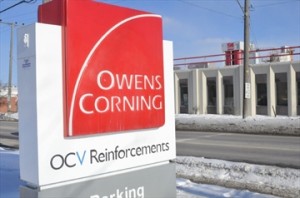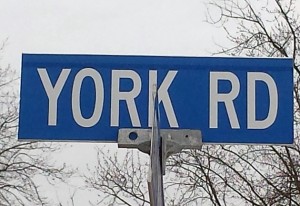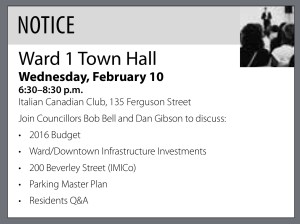The GEERS program is an exciting and ambitious endeavor that I am in support of if implemented correctly. To protect the universal benefit to all in Guelph however, Council needs to ensure the administrative burdens of the program are in line with realistic revenue projections. In short, it must be revenue neutral or revenue positive for the city.
Category: Uncategorized (Page 9 of 12)
After reading a fair bit of commentary about Guelph Municipal Holdings Inc and it’s relationship with the CEI in recent weeks, I felt it necessary to clarify some of my positions and further explain my motion on Feb 22, 2016 calling for an independent investigative audit of large capital CEI projects.
As part of my commitment to transparency, I accept the fact that my support for the Community Energy Intiative (CEI) and it’s ambitious environmental and economic goals must include a willingness to evaluate its progress. To this point, I believe taking stock in the CEI’s strengths and weaknesses in a transparent manner is an integral process for our community to undertake. This type of critical evaluation safegaurds us from leaning solely on the vision of the CEI, and allows us to progress to the question: After almost 10 years, are we achieving our goals? Continue reading
Courtesy: Guelph Today
February 22, 2016
On the surface it’s a rather mundane open house regarding environmental impacts to possible road widening, sidewalks and sewers along the York Road corridor.
But in the big picture Tuesday’s open house on the York Road Environmental Design Study is a publicly visible sign that potentially big changes are on their way to that area of town.
Courtesy: Guelph Today
Feb 11, 2016
It appears it might be time to throw in the towel on Loblaws bringing a grocery store to Guelph’s east side.
At a Ward 1 town hall meeting Wednesday night, councillors Bob Bell and Dan Gibson sounded like it might be a dead issue.
“I’ve given up on them,” Bell told a group of roughly 35 who gathered at the Italian Canadian Club to hear updates on key Ward 1 issues and engage in discussion with the councillors.
“If Loblaws was going to play ball, we’d love to have them. If not, we move on,” Gibson added. “They say they have intention and a timeline, but until Bob and I see a shovel in the ground we won’t believe them.”
Courtesy Guelph Mercury | January 26, 2016
By James Campbell-Prager
Every year, London’s Budweiser Gardens opens its doors over 200 times to host everything from OHL hockey to the Royal Marine Band to tapings of auditions for “So You Think Can Dance.” Within the next few months Kingston’s K-Rock Centre will host the Frontenacs, a Star Trek tribute concert, and the band Death Cab for Cutie. Municipalities all over Southern Ontario enjoy the pleasures of these multi-purpose performance spaces, and the benefits are clear: not only does the city-as-landlord reap the financial rewards of ticket sales, but the city-as-society gains a communal centre, an indoor, well-furbished, well-equipped space in which citizens can come together not merely for sport, but for music, art, and spectacle – for, in other words, culture.
Every year Guelph’s Sleeman Centre opens its doors about 35 times for OHL games. The other 300-odd days are largely taken-up by private events such as hockey, skating, and sometimes hockey – give or take a Hillside Inside. I’m speaking hyperbolically, but the contrast between Budweiser and Sleeman could not be starker. The city operates the Sleeman Centre as though it were a village arena, an appalling waste of a facility that seats almost five thousand people. It was poor ticket-sales that forced the Centre’s original owners to pass it along to the city in 2005, yet the city has done nothing to diversify Sleeman’s event calendar in the decade since. Its revenue still comes from ice sports, and almost exclusively ice sports.
What would it take to change this? Guelph may not be as big or wealthy as, say, London, but if we cannot ape London’s size there’s no reason we cannot emulate its style. The big infrastructure is already in place – the Centre has four walls, a ceiling, and plenty of seats – what is lacking is the smaller infrastructure. The Centre needs plug-and-play architecture for visiting talent: a decent lighting rig, a proper sound-system, a technical set-up to stop an incoming performer from having to haul a small theatre with them just to play a gig. Acquiring this will require two things: money and political will.
Marty Williams, executive director of the Downtown Guelph Business Association, does not think that money would be too great a hurdle. An investment of $250,000, he says, could bring in “potentially millions of dollars in revenue.” Williams believes that the Budweiser Gardens is good example of a similar investment that made-good, for London is using the draw of the Gardens to fuel business in its downtown core.
It’s a view that Ward 1 Coun. Dan Gibson shares. “Look to Oshawa,” he says, where the General Motors Centre is creating a boom in hotels and shopping centres. Thousands come to the GMC for a show, but stay for the amenities Oshawa has to offer. While the redevelopment of Baker Street may currently hold the attention of council, Gibson believes that for a “fraction of the investment” council could spend on Baker Street, Guelph could make the Sleeman Centre “the iconic, downtown destination of our City.”
It’s reasonable point, and with an economic engine like that enriching the City of Guelph’s coffers, more expensive and extensive redevelopment (such as Baker Street or St. George’s Square) might become more fiscally palatable, not to mention sustainable. After all, there’s little point to rebuilding the downtown if nothing is going to draw people there.
The City of Guelph is very cagey as to whether or not the Sleeman Centre is solvent. I suspect that in good hockey years the Centre breaks-even while in bad years it hemorrhages money. A city asset does not have to be profitable, but it should have more stable finances than the capricious whims of the sporting gods.
I beg council to set aside dreams of a Baker Street Eden and focus on something achievable now: for a few hundred grand and a couple months work, Guelph too could be visited by Death Cab for Cutie. At the very least, this town deserves better than an over-sized arena that drains city coffers every time the Storm’s shots go wide of the net.
As a Ward 1 resident living in Guelph’s east end I have (over the past year) shared some of the concerns related to the Owens Corning Site Specific Standard application to the Ontario Ministry of Environment and Climate Change (MOECC). In terms of my knowledge of this Provincial process, this is what I have learned and I am happy to share with others.
 Photo Courtesy | Guelph Mercury Continue reading
Photo Courtesy | Guelph Mercury Continue reading
Courtesy: Globe and Mail | Michael Babad
January 11, 2016
Welcome to Guelph
The folks at the Vienna Restaurant in downtown Guelph, Ont., were too to busy to talk to me when I phoned around brunch time yesterday to get some information about the diner, asking me nicely to call back later.
I could tell from the background noise alone.
But that told me a lot about what I already suspected were the good times in this small city about an hour away from Toronto, depending on how fast you drive.
It’s a cute city, crime is low and there are a lot of university kids. And, notably, it leads the country on the jobs front.
Guelph has generally had lower unemployment. But a rejigged ranking of Canadian cities by BMO Nesbitt Burns puts it in top spot, with jobs growth of more than 9 per cent in December compared with a year earlier, an employment rate of 72 per cent that’s the best in the country, and a jobless level that is among the lowest and now down almost a full percentage point from late 2014.
“Guelph tops the list with robust job growth, population inflows, a puny 4.2-per-cent jobless rate and the highest share of the population that is working,” BMO senior economist Robert Kavcic noted as he released the rankings after Statistics Canada’s latest labour market report on Friday.
As The Globe and Mail’s Rachelle Younglai reports, that national report showed Canada churned out almost 23,000 new jobs last month, though unemployment held firm at an uncomfortably high 7.1 per cent.
Ontario gained about 35,000 jobs, and its unemployment rate eased to 6.7 per cent. Which brings us back to Guelph, pop. 121,688 at the last official census count a few years ago.
Mr. Kavcic believes Guelph is benefiting from “broadening growth” outside the Greater Toronto Area, as are other nearby communities.
“Plus, they have a more stable and diverse job base (university, health care, etc.) than some others further south/west.”
Guelph’s economy is dependent on no one thing, unlike Oshawa and Windsor where the auto industry rules, though manufacturing has a dominant presence.
The city is also big in life sciences, biotechnology and agriculture-related industries, with a big university presence, boosted by the Guelph-Wellington Business Enterprise Centre and Innovation Guelph.
“I really want to embrace the entrepreneurial spirit,” Mayor Cam Guthrie said in an interview.
The young mayor, who has been in the position since 2014, sells his city well, citing not just the business opportunities, the land available, the five-year transformation of downtown, but also what new businesses are looking for in terms of the feel, from arts festivals to cafés to music “spilling onto the streets.”
Mr. Guthrie – you can call him “Mayor Cam” but please not “Your Worship” – said he sells businesses not only on the amenities you’d find in big cities, but also on “that small-town community feel and community spirit that is just difficult to find anywhere else.”
Major private employers in the city include auto-parts maker Linamar, The Co-operators insurance group and RWDI, a wind and environmental engineering firm headquartered in Guelph that Mr. Guthrie said is looking to double its work force.
The mayor and his council are juggling a lot: Among other things, there’s a 200-acre business park under development, with the first phase already serviced.
And along with the efforts of the Guelph economic development department, there’s a business retention team aimed at helping existing employers expand.
They sell diversification, and there’s a new tourism strategy to focus on just a couple of areas that the stakeholders believe they’re good at.
Guelph’s official plan projects 45,000 to 50,000 more people by 2031, and there’s now construction under way to house an estimated 9,000 in the downtown core, where it’s important to work and live.
From the banker to the butcher, as Mr. Guthrie put it.
And the folks at the quaint Vienna, which has been around in various forms for about a century, offers bottomless coffee, buys locally and is home to “the famous Vienna breakfast.” And the mayor dined there just last Friday.
You’d know the type of place as soon as you saw it.
Despite some varying opinions on process, I’d like to focus first and foremost on the positives stemming from the 2016 Capital and Operating Budget deliberations.
Capital Budget (unanimously approved 13-0)
One of the highlights for me in this years capital budget is the committment to funding the construction of a new downtown parking structure in 2016. This investment is aimed at moving our downtown forward and seeks to alleviate parking impediments to residents looking to work/shop/dine downtown. In addition there are also funding commitments in 2016 to address much needed buried and surface infrastructure upgrades in the St. Patrick’s Ward area (see more here) as well as new funding allocations to improving accessibility on our city streets and intersections ($175,000 committed to installing accessibility ramps).
Finally, one of the most significant investments being made in 2016 will be approximately $5.8M (9.5% of total capital budget) to Guelph Transit. These investments include a computer-aided vehicle dispatch system, transit terminal upgrades at the VIA Station, bus shelter purchases, vehicle and equipment replacements, farebox upgrades to improve machine generated transfers, and finally bus stop accessibility upgrades in order to meet the province’s accessibility standards (AODA). I highlight these investments because I believe it is important to champion the many improvements coming to Guelph Transit in 2016 and I encourage everyone to support our local service.
Operating Budget (Passed 7/6)
In regards to the operating budget, I believe the 7/6 vote accurately reflects the way in which this budget was built (I voted against the budget). It took two days and over 12 hours but in the end a 2.99% increase will now be levied across the city in 2016. Much will be made about how this budget was landed on however, I’m choosing instead to focus on two positive outcomes that I believe will serve Guelph well in the future. The first is the addition of an asset management office within city hall. I believe this addition (in conjunction with other internal reviews) is a fundamental piece to addressing the city’s growing infrastructure deficit. As I’ve stated before, when it comes to replacing infrastructure, simply raising more revenue through taxes, user fees and/or special levies will not adequately address the problem. First and foremost the city needs a plan and (to this end) I look forward to working collaboratively with the new asset manager and technical analyst on this when they arrive in 2016.
Secondly, the approved budget will also finally see staff begin to address the condition of our city sidewalks in 2016. Specifically, more than $400,000 will be added to the operating budget in 2016 to address this issue. Staff have informed us that it may take up to three years to address the existing backlog however, with funding now included in the base operating budget, sidewalks will have reliable, annual funding to address their condition moving forward.
As always if you have any questions/concerns about the 2016 Budget, please do not hesitate to contact me. I’d love to hear from you.
Regards…..,
Dan Gibson
Ward 1 City Councilor
[email protected]
519-827-6407 (c)
www.ward1guelph.ca
@ward1guelph
As the city continues to market the IMICO property at 200 Beverley, two exciting funding allocations were unanimously approved (13-0) by City Council during the 2016 non-tax supported budget and capital budget processes.
Specific to the approved Capital works budget, over $1M was allocated to existing roadway reconstruction projects detailed in the St. Patrick’s Ward Community Improvement Plan. Further, as part of the Water/Wastewater budget, funding was also approved for upgrading buried infrastructure in the same areas. By coupling these funding needs together, sewer replacement, watermain replacement and stormwater replacement will all coincide with roadway reconstruction as part of a comprehensive asset management renewal program for the Ward.
So how does this help IMICO? Continue reading



